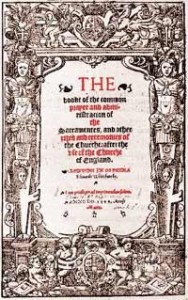 I know that this Sunday, the Day of Pentecost, some communities will celebrate using the 1549 Book of Common Prayer. They are doing this to commemorate the anniversary of its introduction. It was a very catholic prayer book. In 1552 a more reformed prayer book ensued, but this did not come into use because, on the death of Edward VI, his half-sister Mary I re-introduced Latin worship, re-establishing the link with Rome. Contemporary prayer book reforms have moved from the revised 1552 position (1559, 1662) in the direction of 1549 – from Lambeth east, beyond Geneva, and even further Eastwards than Rome, drawing on Eastern Orthodox liturgical insights and traditions in contemporary Anglican liturgy.
I know that this Sunday, the Day of Pentecost, some communities will celebrate using the 1549 Book of Common Prayer. They are doing this to commemorate the anniversary of its introduction. It was a very catholic prayer book. In 1552 a more reformed prayer book ensued, but this did not come into use because, on the death of Edward VI, his half-sister Mary I re-introduced Latin worship, re-establishing the link with Rome. Contemporary prayer book reforms have moved from the revised 1552 position (1559, 1662) in the direction of 1549 – from Lambeth east, beyond Geneva, and even further Eastwards than Rome, drawing on Eastern Orthodox liturgical insights and traditions in contemporary Anglican liturgy.
There had been a month of debate in the English parliament about this Prayer Book. Then on 21 January 1549 they passed the first Act of Uniformity. This included a draft of a new “convenient and meet order, rite, and fashion of common and open prayer and administration of the sacraments.” It had been prepared by a committee of “the most learned and discreet bishops, and other learned men of this realm.” On the Day of Pentecost (called “Whitsunday”) of 1549 (June 9), all clergy were required to follow this Prayer Book. If you used something else, or didn’t use this, or disparaged the Prayer Book there were penalties from £10 to life imprisonment and losing all your property.
And where heretofore, there hath been great diversitie in saying and synging in churches within this realme: some folowyng Salsbury use, some Herford use, same the use of Bangor, some of Yorke, and some of Lincolne: Now from hencefurth, all the whole realme shall have but one use. And if any would judge this waye more painfull, because that all thynges must be read upon the boke, whereas before, by the reason of so often repeticion, they could saye many thinges by heart: if those men will waye their labor, with the profite in knowlege, whiche dayely they shal obtein by readyng upon the boke, they will not refuse the payn, in consideracion of the greate profite that shall ensue therof.




Our Parish inventory from 1490 lists both a gold and silver pax – to be kissed during the Mass of Sarum Use…. maybe they’re still here somewhere? Time to go looking behind the vestry cupboards as they may have escaped both the reformers’ zealous liturgical shredding and the Anglican Diocesan Advisory Ctte’s inquisitions. So sad that so little remains of the great church in England before it became The Church of England – all the colour, mystery and richness exchanged for uniformity and dull, dull puritanism.
Thanks for the heads up, Bosco!
1549 was part of the Great Reform of the Church of England. Unlike MarkG I do not mourn the passing of colour, mystery and richness since whatever that was, it carried within it the seeds of its own destruction. If all were well in 1548, why reform? If Mary’s reversion was so universally welcomed and celebrated, why reform again?
I prefer to celebrate the great gains of 1549 and 1552: a reformed Church of England!